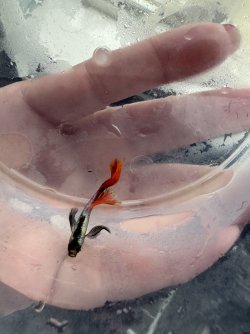charlotteay
New Member
Hi, this is my first time posting and I have no idea what to do. I’ve only owned my guppies for three months so I’m quite new to fish keeping.
I found my smallest guppy (Canyon) struggling to swim this morning. I found him struggling near the bottom but when I came near, he was twirling upwards. I have no idea what’s caused this, my other 5 guppies are fine. He is gasping for air so I’ve set up a little container while I rush to get a little floating container with holes from my local store.
I had an issue with one guppy who had his tail a bit bitten so to prevent fin rot/make sure it wasn’t, I did a treatment of Waterlife fin rot and ulcers that has Myxazin in. I had it on had so I thought it would be fine. The treatment ended 4 days before this.
I have done a water change and added the oxygen pump to the water. The only reason I don’t have it all the time is because at the moment I only have plugs for the heater, light and pump.
My tank is 54L, I have 6 guppies all together and a few shrimp. The temperature is 25.3, pH is at 8 (normally it’s 7.4-7.8), nitrite 0ppm and ammonia looked between 0-0.25ppm. Lastly, I spilt one test tube that I did before I performed a water change so I used a test strip for the nitrate which was 0ppm. They got this new upgrade a few weeks ago and have been fine. Today was supposed to be water change day which I do weekly.
I found my smallest guppy (Canyon) struggling to swim this morning. I found him struggling near the bottom but when I came near, he was twirling upwards. I have no idea what’s caused this, my other 5 guppies are fine. He is gasping for air so I’ve set up a little container while I rush to get a little floating container with holes from my local store.
I had an issue with one guppy who had his tail a bit bitten so to prevent fin rot/make sure it wasn’t, I did a treatment of Waterlife fin rot and ulcers that has Myxazin in. I had it on had so I thought it would be fine. The treatment ended 4 days before this.
I have done a water change and added the oxygen pump to the water. The only reason I don’t have it all the time is because at the moment I only have plugs for the heater, light and pump.
My tank is 54L, I have 6 guppies all together and a few shrimp. The temperature is 25.3, pH is at 8 (normally it’s 7.4-7.8), nitrite 0ppm and ammonia looked between 0-0.25ppm. Lastly, I spilt one test tube that I did before I performed a water change so I used a test strip for the nitrate which was 0ppm. They got this new upgrade a few weeks ago and have been fine. Today was supposed to be water change day which I do weekly.
Attachments
Last edited:






